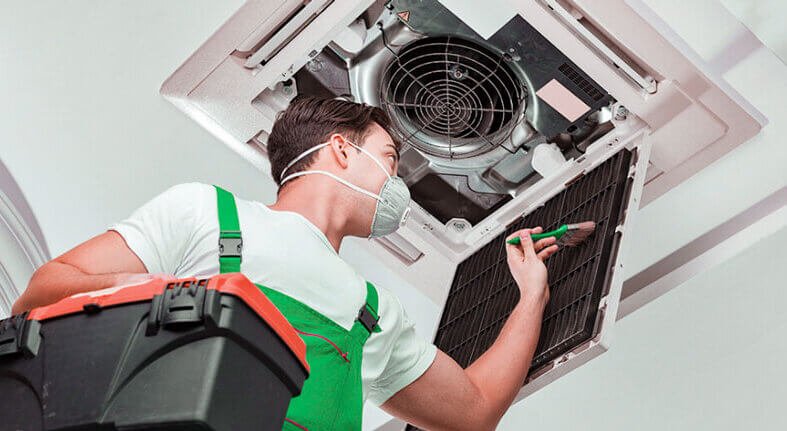Did you know that up to 30% of conditioned air is lost due to duct leaks, holes, and poor connections? These issues drive up energy bills and compromise indoor air quality. The solution lies in proper duct maintenance.
Duct access doors provide easy entry points for inspecting, cleaning, and repairing ductwork. This article will explore how they can boost HVAC efficiency, cut costs, and improve indoor air quality.
Why Does HVAC Maintenance Matter?
HVAC maintenance is important to ensure the system operates efficiently and effectively. It helps prevent unexpected breakdowns, reducing costly repairs and downtime.
Additionally, well-maintained systems use less energy, lowering utility bills. Lastly, proper maintenance ensures better indoor air quality by removing dust, allergens, and other contaminants.
What Are Duct Access Doors?
Duct access doors and panels are openings installed in HVAC ductwork to allow inspection, cleaning, and maintenance access. These doors are typically found in areas where ductwork is accessible, such as attics, crawl spaces, and mechanical rooms.
In commercial buildings, they are often in plenums or between the ceiling and roof.
Benefits of Duct Access Doors and Panels
Duct access doors impact the HVAC system and building occupant’s comfort in many ways. Here are some of their benefits:
Energy Efficiency
Duct access doors boost energy efficiency by facilitating easier inspections and maintenance. Technicians can quickly identify and address leaks, blockages, or insulation problems, ensuring the HVAC system operates at peak performance.
This proactive approach prevents small issues from escalating into huge energy drains, keeping the system running smoothly.
Cost Savings
Installing duct access doors can lead to substantial cost savings over time. These doors help reduce energy bills through improved system efficiency. They also allow for early detection of potential issues, preventing them from escalating into major, expensive repairs. Data from the U.S. Department of Energy suggests that this practice can save up to 20% on annual costs.
Additionally, the ease of maintenance and timely interventions extend the HVAC system’s lifespan, delaying the need for costly replacements.
Improved Indoor Air Quality
Clean, healthy air is important for any living or working space. Duct access doors allow for thorough cleaning and sanitization of the ductwork, preventing dust, mold, and contaminant buildup.
This enhances ventilation and provides a steady flow of clean air. Occupants can enjoy a healthier environment with reduced allergens and improved respiratory health.
7 Types of Duct Access Doors and Their Applications
HVAC systems benefit from various duct access door designs, each serving different purposes. Consider these popular types:
-
Hinged Duct Access Doors
These duct access doors provide convenient entry to ductwork. They come with hinges that allow the door to open and close easily, making maintenance and inspections more efficient.
-
Self-Stick Duct Panels
Self-stick duct panels—like the HDSS-6020 duct access door—have a strong adhesive backing. These access doors offer a quick and easy installation solution. They are perfect for situations where minimal tools are available, or a temporary access point is needed.
-
Fiberglass Duct Access Doors
As the name suggests, these access doors are designed for fiberglass ductwork. They are typically lightweight and corrosion-resistant, making them suitable for residential and commercial applications.
-
Grease Duct Access Doors
In commercial kitchens, grease duct access doors are essential for regular cleaning and maintenance. These access doors and panels withstand high temperatures and grease buildup, ensuring the ventilation system’s proper functioning.
-
Round Duct Access Doors
Round duct access doors ensure a proper fit on a cylindrical ductwork’s curved surfaces. They are available in various sizes and materials to match different ductwork configurations.
-
High-Pressure Duct Access Doors
These access doors and panels withstand high-pressure HVAC systems. Their reinforced construction and secure sealing mechanisms make them ideal for industrial or large commercial applications.
-
Walk-Through Duct Access Doors
For larger HVAC systems, walk-through duct access doors are available. They are significantly larger than standard access doors and provide ample space for technicians to enter and exit the ductwork.
Key Considerations to Select the Right Duct Access Doors and Panels
When choosing duct access doors, consider these factors to ensure compatibility and optimal HVAC system performance:
System Type and Size
The type and size of the HVAC system will determine the appropriate size and material for the duct access doors. For example, larger systems may require multiple access points, while smaller ones may only need a few.
Material
Duct access doors are available in various materials, including galvanized steel, stainless steel, and fiberglass. When choosing a material, consider its durability, corrosion resistance, and cost.
Insulation Requirements
Preventing heat loss and gain is necessary for areas with extreme temperatures. Access doors and panels with insulation features can help improve the HVAC system’s efficiency.
Pressure Ratings
If the HVAC system operates at high pressure, selecting duct access doors with appropriate pressure ratings is important. These doors withstand higher pressures and prevent leaks or failures.
Local Building Codes
Ensure that the duct access doors comply with local building codes and regulations. These codes may specify requirements regarding size, material, and installation methods.
Conclusion
Duct access doors and panels are essential for maintaining HVAC efficiency, reducing costs, and improving indoor air quality. They facilitate easy inspection, cleaning, and repairs, improving the system’s performance and longevity.
Prioritizing proper maintenance and incorporating duct access doors is a smart investment in health, comfort, and energy savings.








